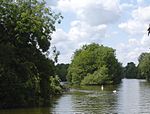Appletree Eyot
Berkshire geography stubsGeography of Reading, BerkshireIslands of the River ThamesUse British English from January 2018

Appletree Eyot is an island in the River Thames at Reading, Berkshire, in England. The island is on the reach above Caversham Lock about 3 km (1.9 mi) from Tilehurst, a suburb of Reading. Poplar Island is very close to it. The two islands are in the middle of the river, so that navigation goes to each side of them according to the rules of the river. Appletree Eyot is densely covered by trees.
Excerpt from the Wikipedia article Appletree Eyot (License: CC BY-SA 3.0, Authors, Images).Appletree Eyot
Deacon Way, Reading Norcot
Geographical coordinates (GPS) Address Nearby Places Show on map
Geographical coordinates (GPS)
| Latitude | Longitude |
|---|---|
| N 51.4677 ° | E -1.0205 ° |
Address
Deacon Way
Deacon Way
Reading, Norcot
England, United Kingdom
Open on Google Maps










